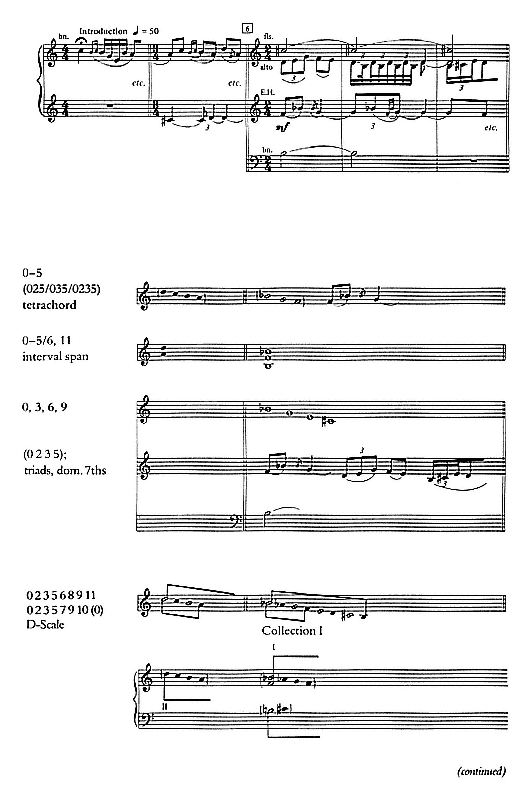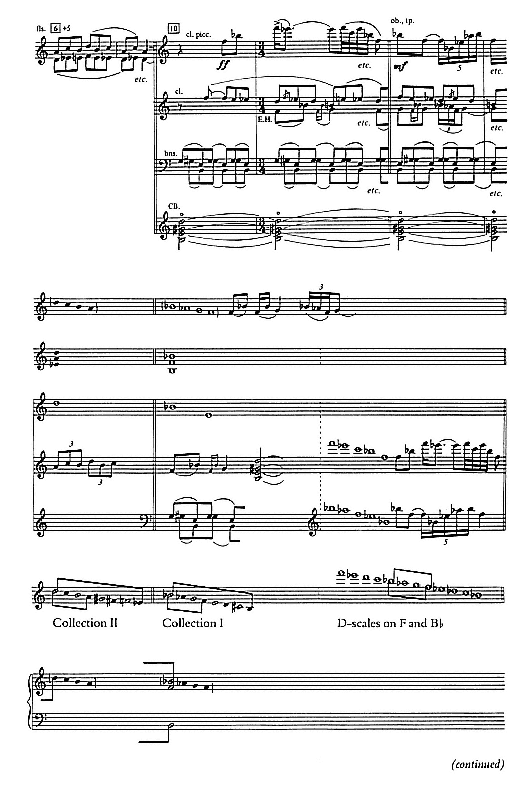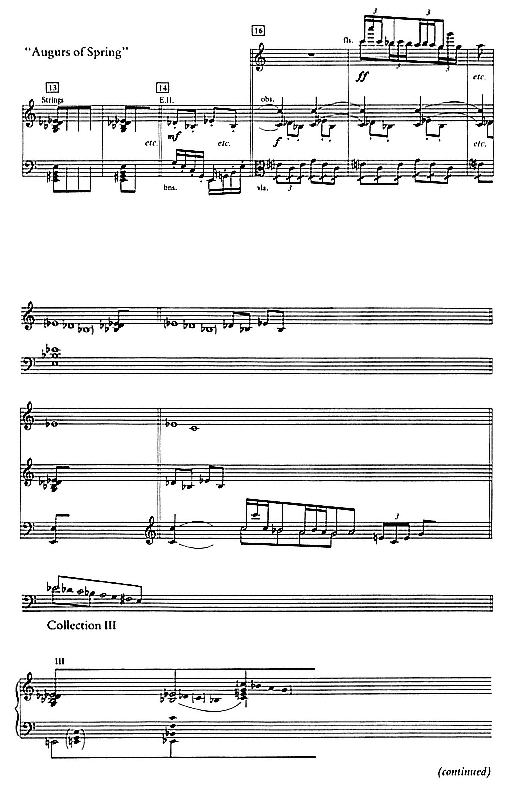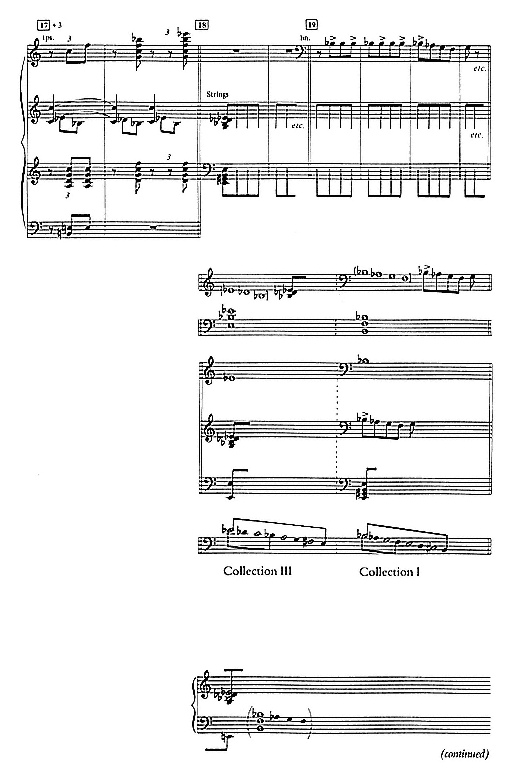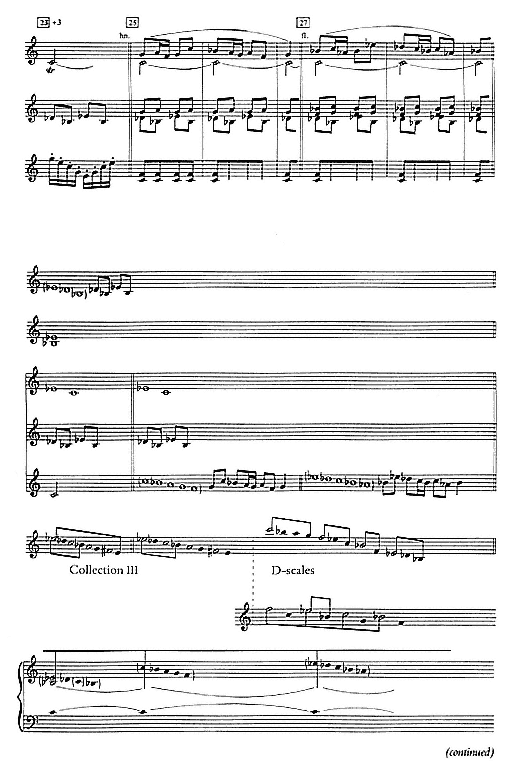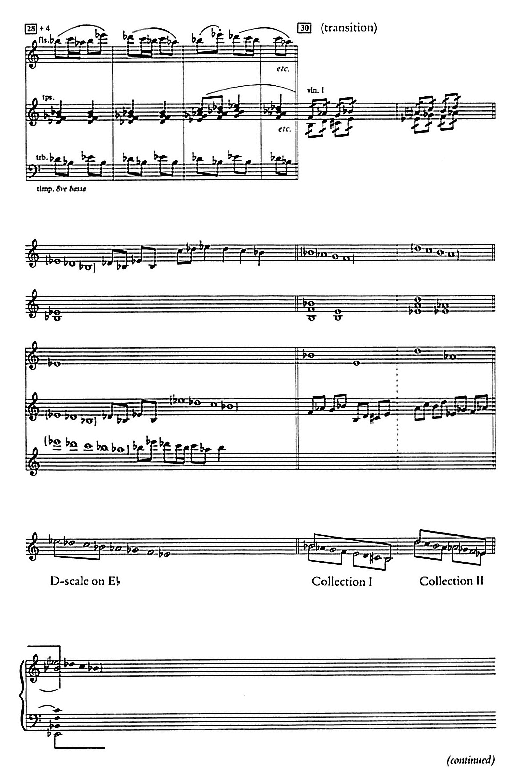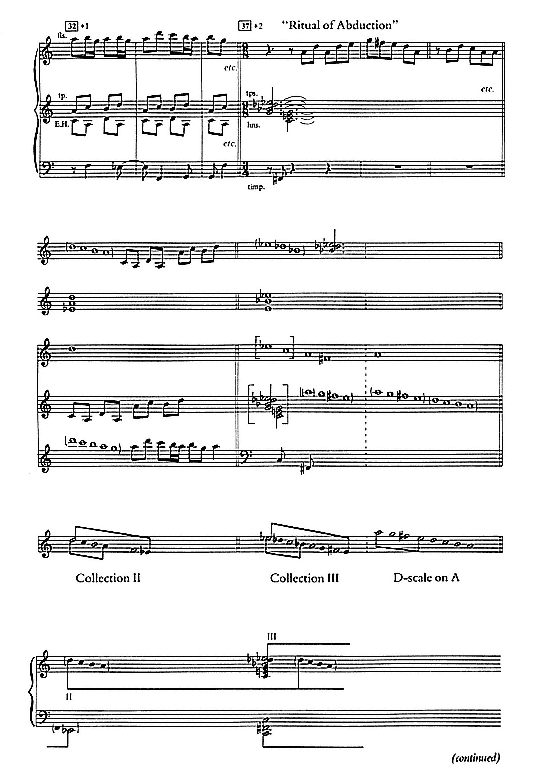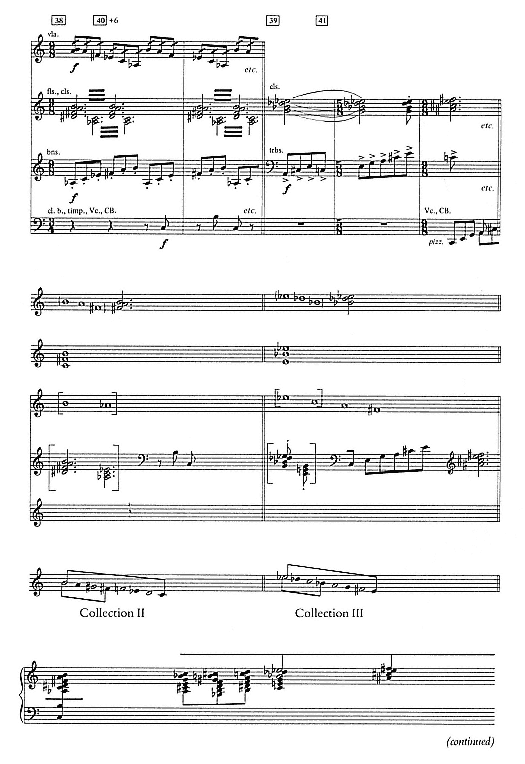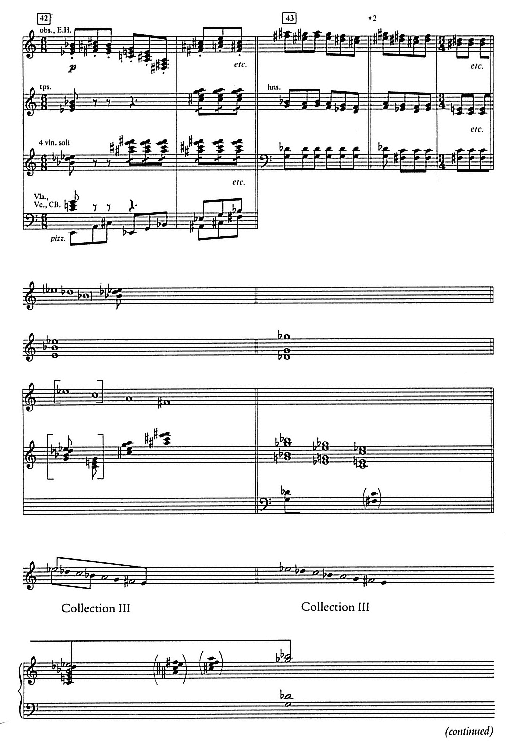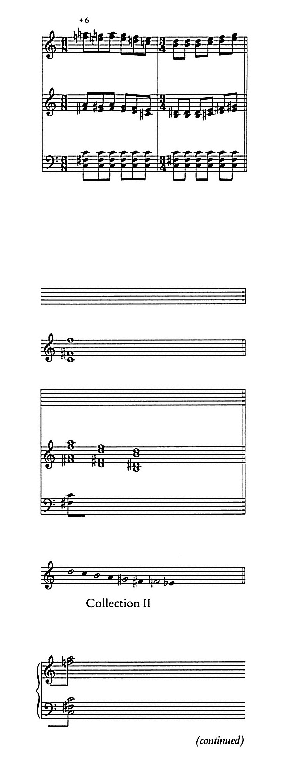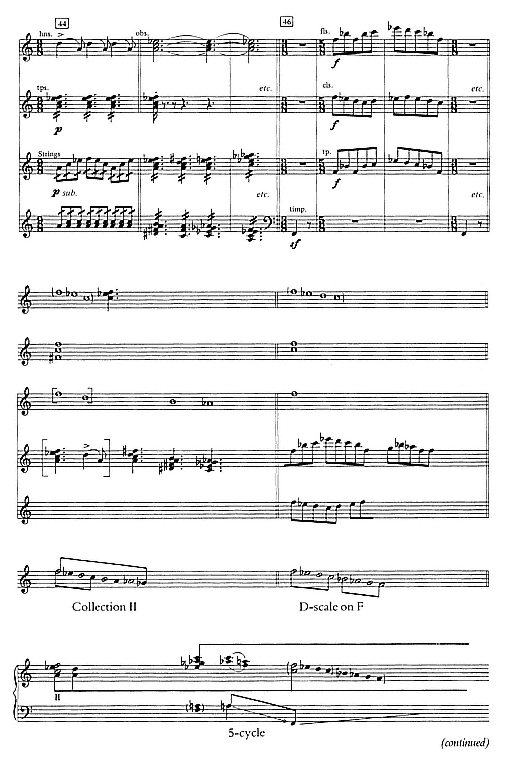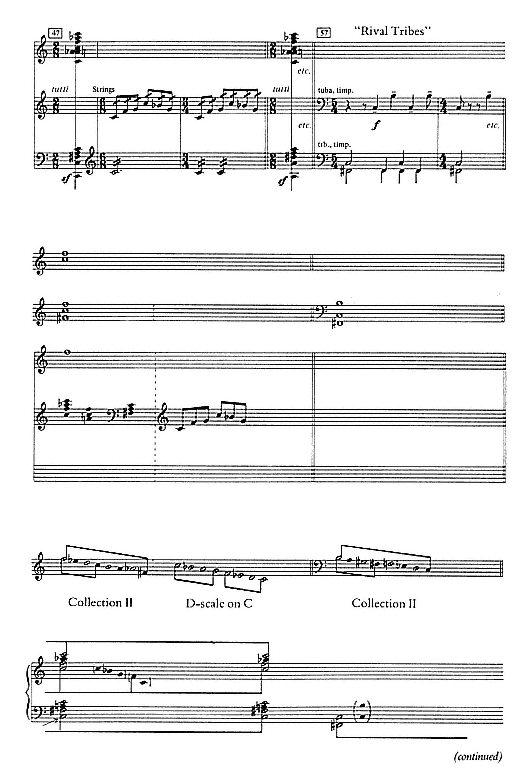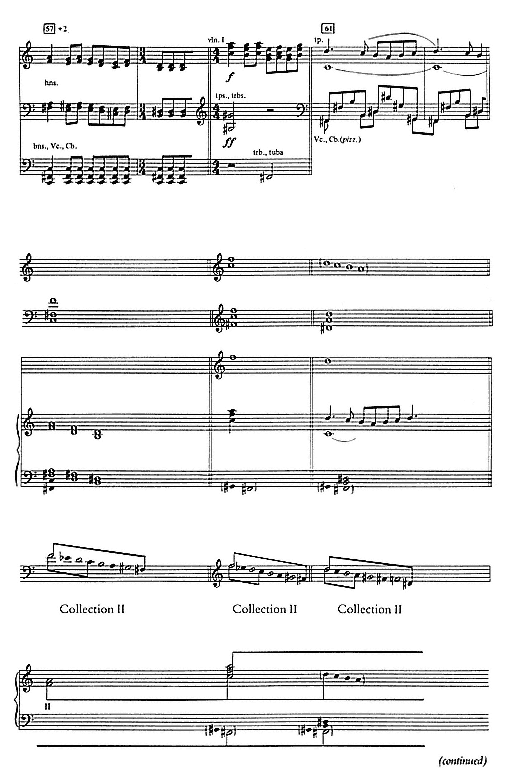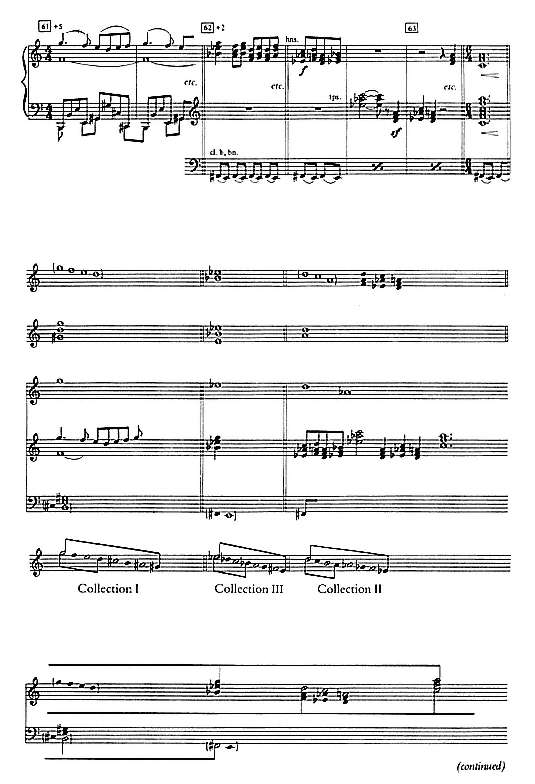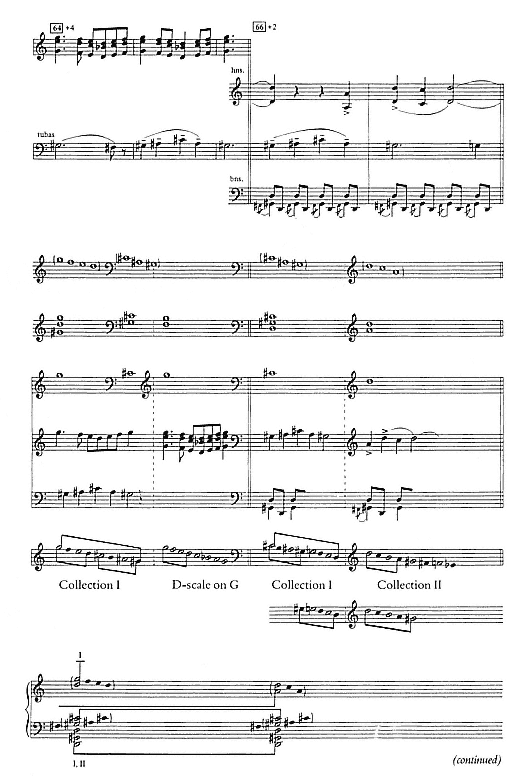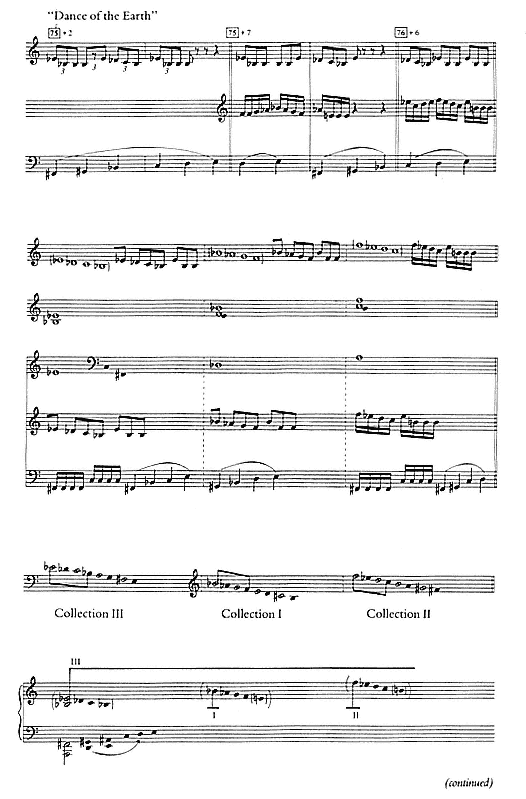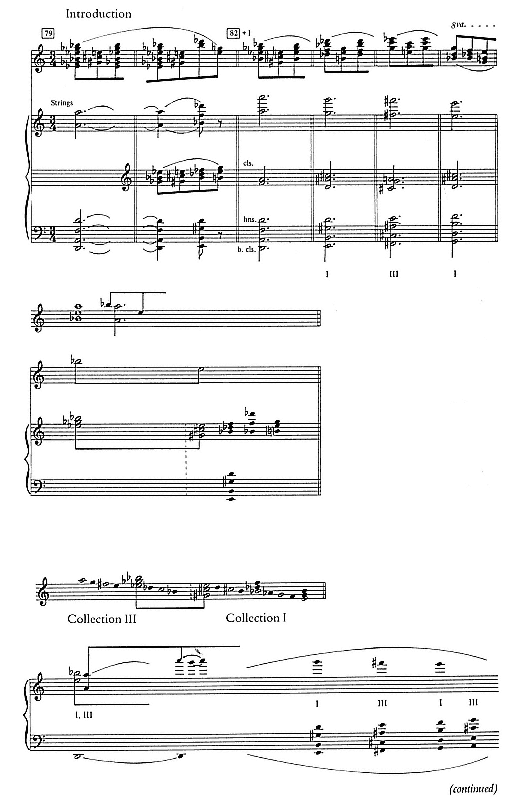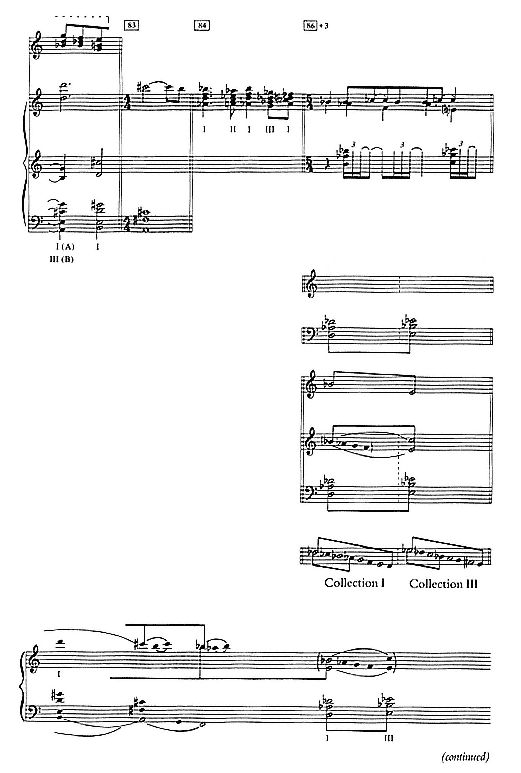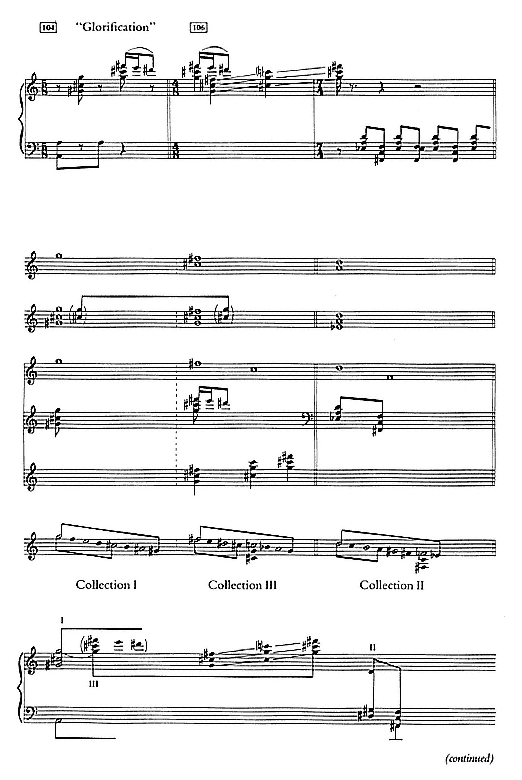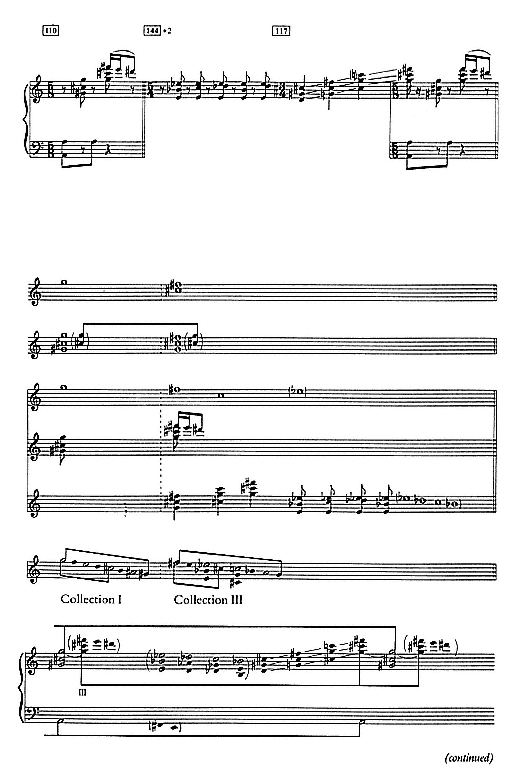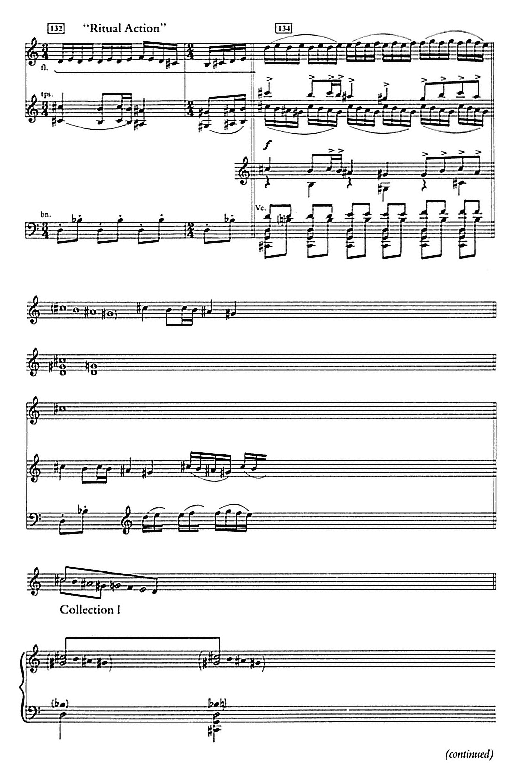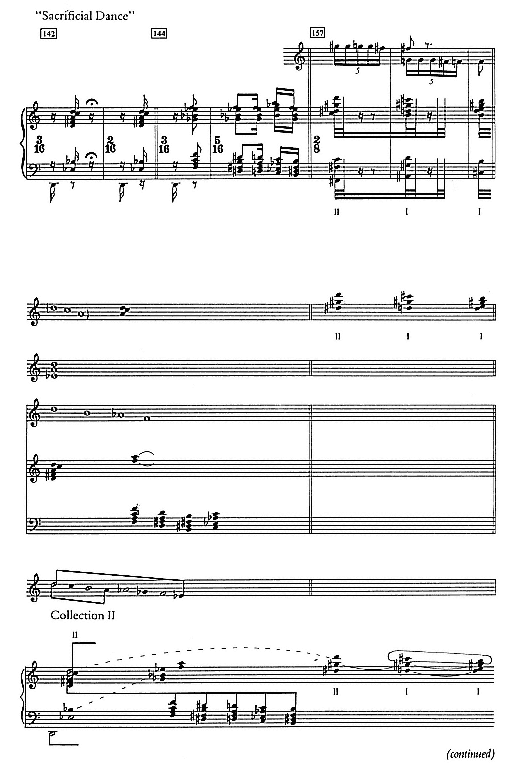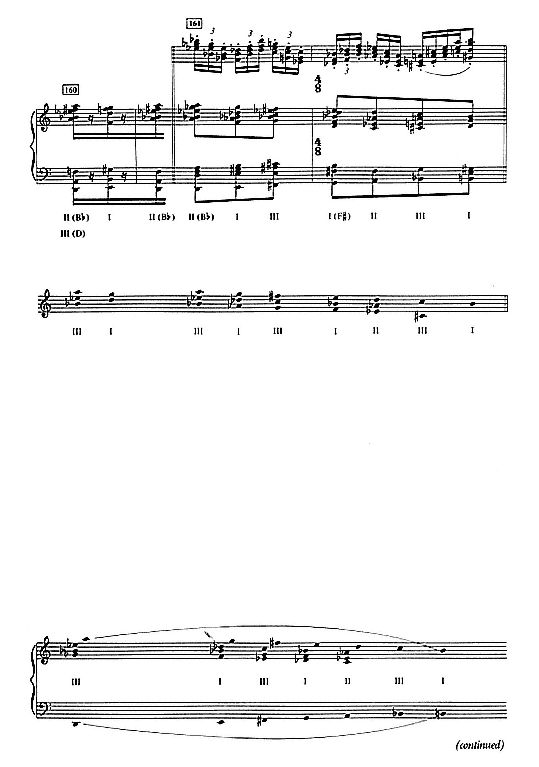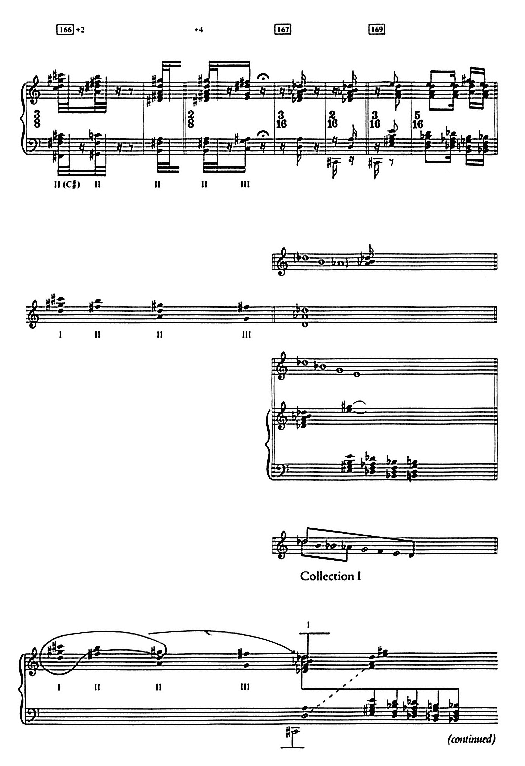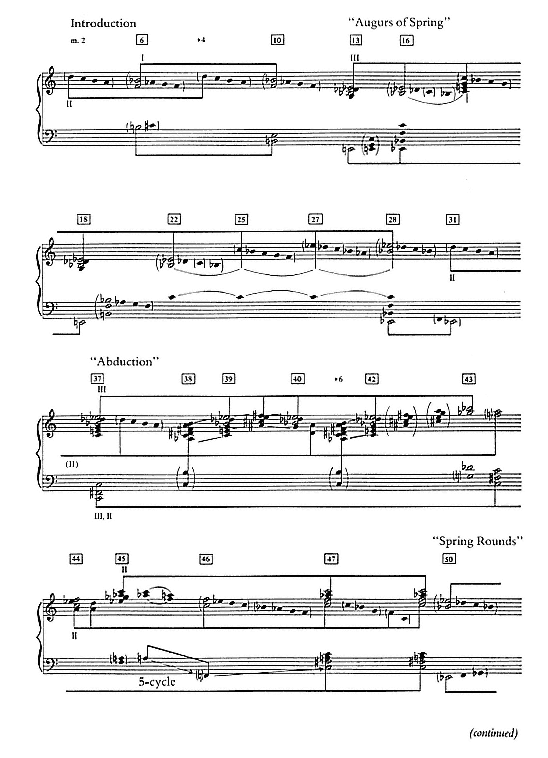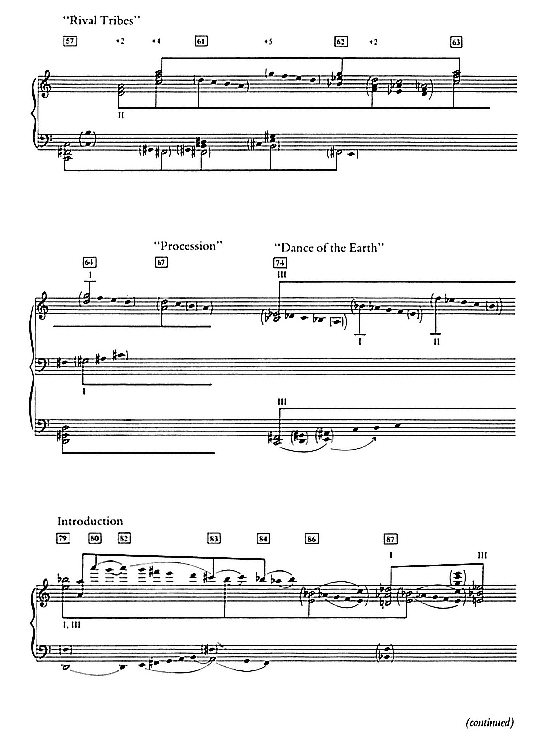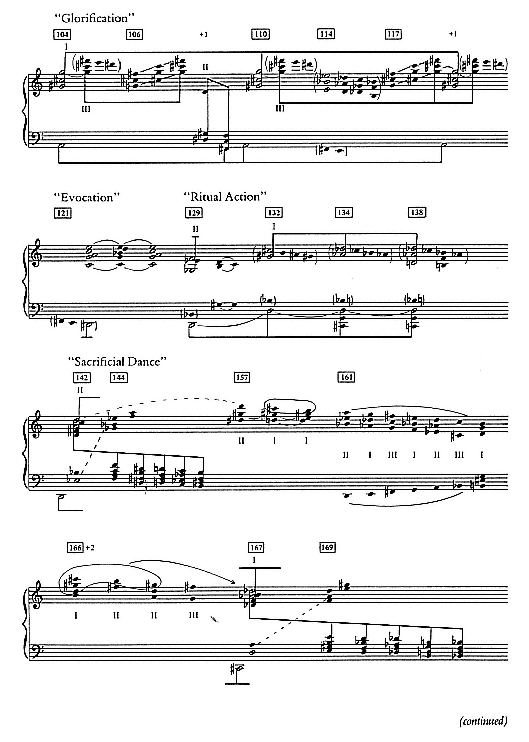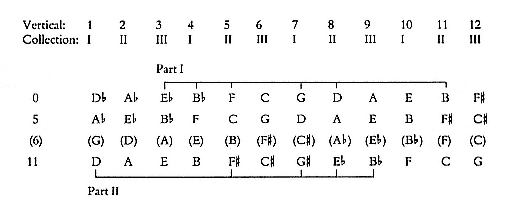Preliminary Survey
In its coverage of both Parts I and II, the analytical portion of Example 65 encompasses four successive stages.[18] Moving from a least to a most determinate stage, the first of these levels recognizes the (0 2 3 5) tetrachord as that unit which, complete or (0 2 5/0 3 5) incomplete, is shared by blocks and sections of varied articulative and referential implications, and hence as that unit which is more or less globally determinate or continuously operative with respect to the whole of The Rite . At the second stage the (0 2 3 5) tetrachord attaches itself to the octatonically conceived 0–5/6, 11 vertical span or shell, a formula that applies to passages of octatonic or octatonic-diatonic content, not to the few scattered patches of unimpaired diatonicism in Part I. The local articulation of these global units, acknowledged at the third level, yields the reference collection at the fourth level, where beams, parentheses, and the like confirm earlier-noted priorities and partitionings.
[18] The format of Example 65 corresponds somewhat to that of Example 27 in van den Toorn, The Music of Igor Stravinsky , pp. 102–22. Here, however, the process has been streamlined. With a view toward The Rite as a whole, the dance movements of both Part I and Part II are taken into account, while the blocks selected for detailed treatment are often different. The accompanying graph, compressed in Example 66, also reflects a concern for The Rite in its entirety.
― 149 ―
Example 65
― 150 ―
Example 65
(continued)
― 151 ―
Example 65
(continued)
― 152 ―
Example 65
(continued)
― 153 ―
Example 65
(continued)
― 154 ―
Example 65
(continued)
― 155 ―
Example 65
(continued)
― 156 ―
Example 65
(continued)
― 157 ―
Example 65
(continued)
― 158 ―
Example 65
(continued)
― 159 ―
Example 65
(continued)
― 160 ―
Example 65
(continued)
― 161 ―
Example 65
(continued)
― 162 ―
Example 65
(continued)
― 163 ―
Example 65
(continued)
― 164 ―
Example 65
(continued)
― 165 ―
Example 65
(continued)
― 166 ―
Example 65
(continued)
― 167 ―
Example 65
(continued)
― 168 ―
Example 65
(continued)
― 169 ―
Example 65
(continued)
― 170 ―
Example 65
(continued)
― 171 ―
Example 65
(continued)
― 172 ―
Example 65
(continued)
― 173 ―
Example 65
(continued)
― 174 ―
The graph that runs at the foot of Example 65, pages 149–73, shows the general direction of the block and sectional transpositions, a sketch that is further compressed in Example 66. For the moment it will be useful to survey some of the initial realizations.
At no. 6 in the Introduction, the (0 2 3 5) tetrachord in the English horn—(0 (2) 3 5), incomplete in terms of (B
(A
) G F)—is the principal melodic fragment. Traced to the climactic block at no. 10, (B
(A
) G F) is confined to a B
-B vertical span, defined at no. 6 between the tetrachord's B
and the low B sustained in the bassoon. At no. 10 the dominant seventh on E is significantly second inversion, allowing B to remain stationed in the bass. Note the (G F E D) tetrachord in the alto flute at no. 6, which relates to (B
(A
) G F) by the interval of 3. This (0, 3) relationship between superimposed fragments is one that persists in the movements directly ahead.
These relations are sustained in terms of (E
D
(C) B
) and E
-B
, E at nos. 13 and 14 in the "Augurs of Spring." The principal fragment is the D
-B
-E
-B
ostinato in the English horn, an (0 2 (3) 5) incomplete tetrachord in terms of (E
D
(C) B
). The contour of the ostinato is foreshadowed by the Introduction's opening bassoon melody, whose C-A-D-A phrase identifies with D
-B
-E
-B
.
[19] Hence the vertical arrangement at nos. 13–14 is E
-B
, E, with the (E
D
(C) B
) incomplete tetrachord of the (E
D
B
G) dominant seventh and ostinato superimposed over a lower E in the bass.
Critical at nos. 13–19 is the mixed (0 2 3 5) tetrachordal, triadic, and dominant-seventh articulation. As noted already, (E
D
B
G) preserves, in simultaneity, the ostinato's incomplete (E
D
(C) B
) tetrachord; E
, D
, and B
of the ostinato merely become the root, seventh, and fifth, respectively, of (E
D
B
G). And so the rationale of the tight, first-inversion articulation of the dominant seventh is as follows: registrally fixed at nos. 13–15, this disposition exposes the persistence of E
, D
, and B
as a tightly articulated (E
D
(C) B
) tetrachord. Hence, too, the frequent (0 2 5) incomplete articulation of the (0 2 3 5) tetrachord in
The Rite ; (0 2 5) becomes the connecting link between these tetrachordal and dominant-seventh partitionings of the octatonic collection. In addition, the (0, 3) relationship persists in terms of (E
, C). This is realized tetrachordally in terms of the D
-B
-E
-B
ostinato and the (C B
A G) fragment in the flutes at no. 16, and then triadically in terms of (E
D
B
G) and the (C E G) triad. At nos. 14 and 16 (E
D
B
G) (C E G) preserves the E
-E vertical span, with E as the major third of (C E G). Hence the 0–5, 11 octatonic presence is realized articulatively by means of an upper (0 2 3 5) tetrachord sustained over a lower pitch number 11 or by means of a dominant seventh, closed position, first inversion, superimposed over a (0, 3)-related major triad, also closed position. Note the (E G C) first-inversion articulation of the (C E G) triad at no. 14, with E as pitch number 11 in the bass.
[19] A more detailed account of Part I's Introduction is given in van den Toorn, The Music of Igor Stravinsky , pp. 102–6, 124–26.
― 175 ―
Example 66
― 176 ―
Example 66
(continued)
― 177 ―
Example 66
(continued)
― 178 ―
Example 66
(continued)
The transposition of the (C B
A G) flute melody at no. 16 to (B
A
G F) in the bassoons at no. 19 introduces an added complexity: (B
A
G F) refers not to Collection III but, rather, to Collection I. Indeed, the transposition points to the hybrid character of the celebrated motto chord itself, which is not an octatonic entity; its (E
D
B
G) top half refers to Collection III, while its (E G
B) bottom half refers to Collection I. True, the prominence of the (E
D
B
G) dominant seventh and its superimposition over E guarantee Collection III's hegemony throughout most of the "Augurs of Spring" and the succeeding "Ritual of Abduction" as well; see, especially, Collection III's triadic and tetrachordal articulation at nos. 13–19, 22–25, 37, and 42. Yet both G
(A
) and B of the motto chord are foreign to Collection III, while, excluding the important E
, the pitch content of the chord refers equally to Collection I. Hence, as shown in Example 65, the chord may smoothly accommodate blocks referring to either Collection III or Collection I. And in addition to the transposition to (B
A
G F) at no. 19, note the B/E-G
/C
-B
syncopated, upbeat figure at no. 15, where the material, once again excluding E
as root of the (E
D
B
G
) dominant seventh, refers wholly to Collection I.
Indeed, the embedded fourths in this Collection III-Collection I exchange at no. 19 (E
-B
over B
-F, for example) point to yet another referential factor in
The Rite , that of the interval-5 cycle or cycle of fourths.
[20] There is much explicit evidence to support its role, and with particular reference to the many diatonic fragments in Part I, a topic to be discussed just below. Consider,
[20] The role of the interval-5/7 cycle in The Rite is briefly discussed in George Perle, "Berg's Master Array of the Interval Cycles," Musical Quarterly 63, 1 (1977): 10–12, and in Elliott Antokoletz, The Music of Béla Bartók , pp. 313–18. Pursuant to The Rite 's (0 2 3 5) tetrachords and the present descending approach in scale formation, emphasis is here placed on the descending 5-cycle rather than on the complementary 7-cycle (although, of course, explicit 7-cycle segments do occasionally arise in the "Augurs of Spring"). Chart 5, Example 68, and Charts 7–11 just ahead are plotted accordingly.
― 179 ―
however, the broader implications of the cycle's intersecting role as suggested by the transposition to (B
A
G F) at no. 19 and its superimposition over the motto chord. Reading from left to right in Chart 5, four different rotations of the interval-5 cycle are aligned vertically in accord with the 0–5/6, 11 span. This arrangement yields twelve 0–5/6, 11 verticals, which are numbered accordingly. In addition, the collectional affiliations of these verticals are shown, while lines and beams trace the degree of emphasis exercised by each in Parts I and II. Verticals 3 and 4 are of obvious concern in the first part of the "Augurs of Spring," while vertical 5 is crucial to the "Rival Tribes" until the climactic section at no. 64, at which point vertical 7 surfaces. The "Dance of the Earth" at nos. 75–79 consists almost entirely of transpositions involving verticals 3, 4, and 5 or, alternatively, the E
-B
-F-C segment of the 5-cycle. Part II exhibits a different set of priorities. The blocks at nos. 132, 134, and 138 in the "Ritual Action of the Ancestors" expose vertical 1, while transpositions of the opening section of the "Sacrificial Dance" entail verticals 8, 1, and 9, respectively. The four rotations in Chart 5 could have been cut off at the tritone, since the upper and lower tritone-related fourths merely begin a series of duplications at this point. In view of the significance attached to upper and lower placement, however, it seemed advantageous to include all the relevant formations. Whether the actual block-by-block progressions defined by these verticals exhibit, with respect to the interval–5 cycle and/or collectional affiliation, a meaningful hierarchical scheme for
The Rite as a whole is a matter to be considered presently.
Returning to the purely local conditions of the "Augurs of Spring," the introduction of the new (C B
A G F) fragment in the horn at no. 25, transposed to (E
D
C B
A
) at no. 27, undermines the octatonic advantage. The fragment anticipates the climactic stretch at nos. 28–30, a diatonic block im-
Chart 5
― 180 ―
Example 67:
Sketchbook
plicating the D-scale (or Dorian scale) on E
. Here, E
and the upper (E
D
C B
) tetrachord prevail as connecting links, while the remaining non-Collection III elements are eliminated; A, G, and E are gradually replaced at nos. 25 and 27 by A
, G
, and F.
Interestingly, the new (C B
A G F) fragment at no. 25 was initially conceived as part of a more fully committed Collection III framework. Reproduced in Examples 67a and 67b are two entries from pages 5 and 6 of the sketchbook, where the fragment's (C B
A G) tetrachord is superimposed over its lower tritone-related (G
(F
) E
D
) unit.
[21] In the second of these sketches, Example 67b, this explicit 0–5/6, 11 configuration, C-G/G
, D
, is superimposed over the D
-B
-E
-B
) ostinato. Yet, at the bottom of page 6 these overt octatonic overtones are purged in favor of the more ambiguous octatonic-diatonic setting as it presently stands. Only the F of the (C B
A G F) fragment remains foreign to Collection III at no. 25, however. The D
-B
-E
-B
ostinato and its tritone-related A-G whole-step reiteration in the second violins continue to mark Collection III's presence.
Coming by way of the transition at no. 30, the (E
D
C B
) tetrachordal emphasis at nos. 13–30 is transposed to (D C B A) at nos. 31–37. The 0–5, 11 vertical span perseveres in terms of D-A, E
, with E
positioned in the bass.
